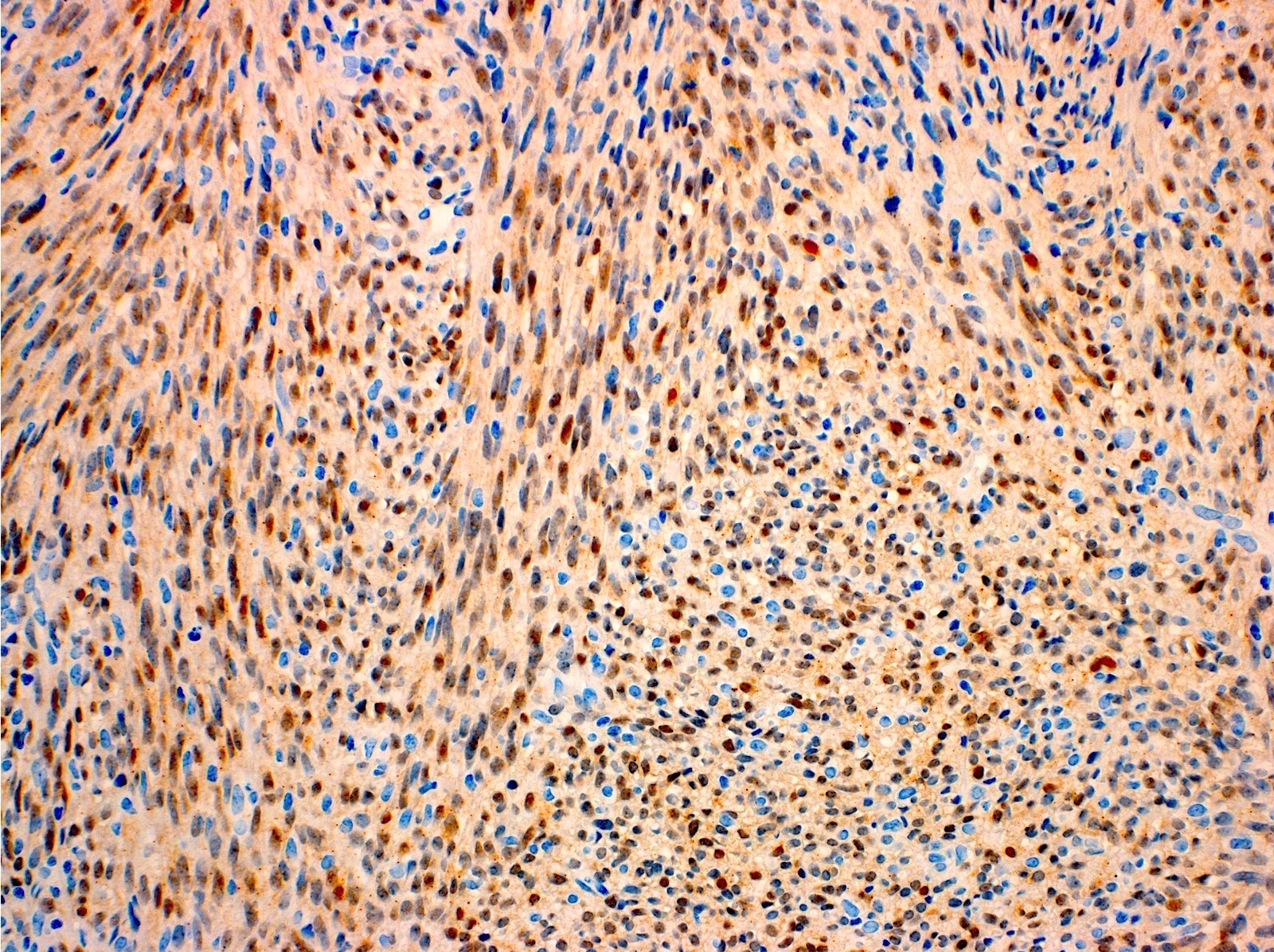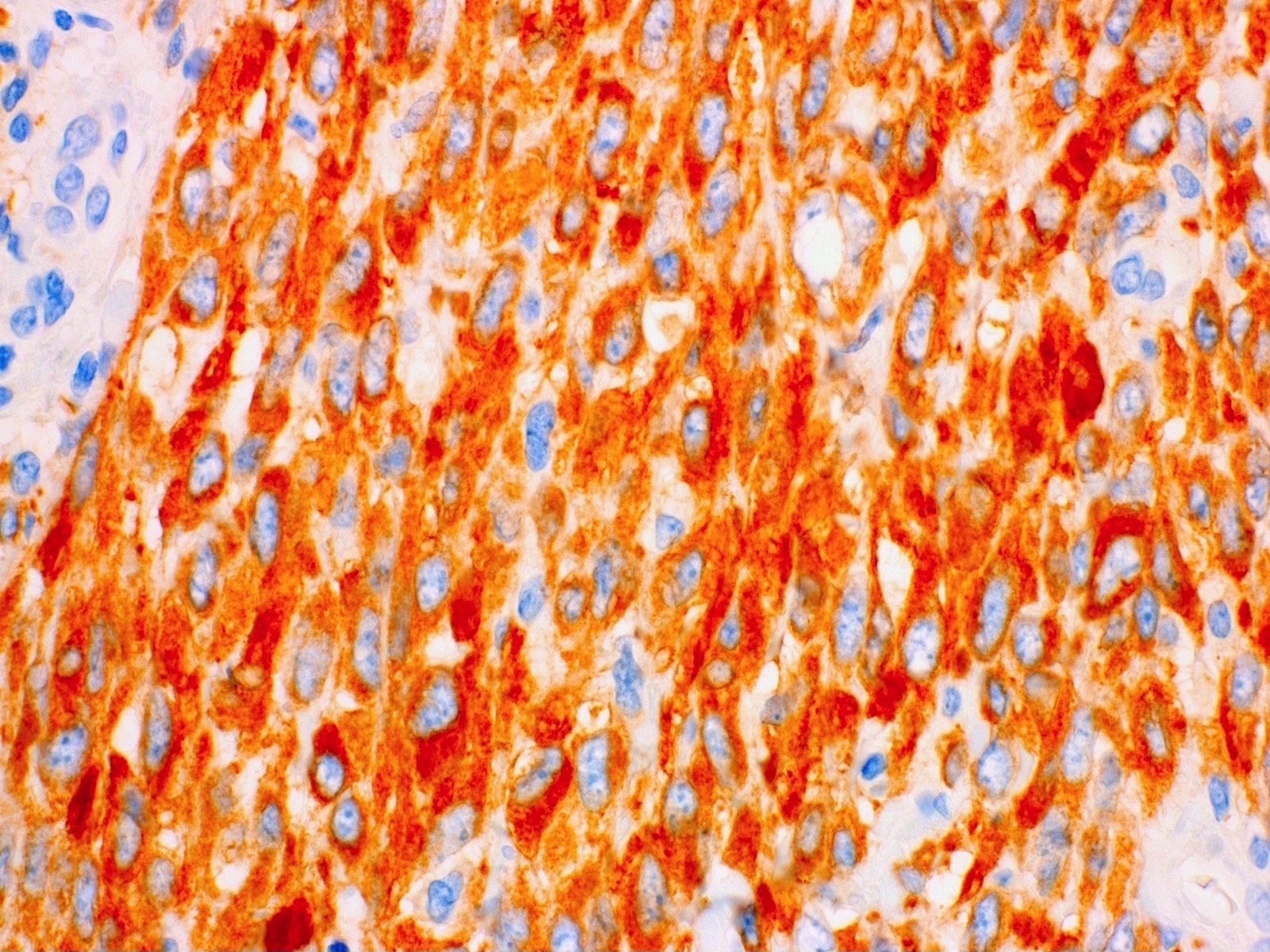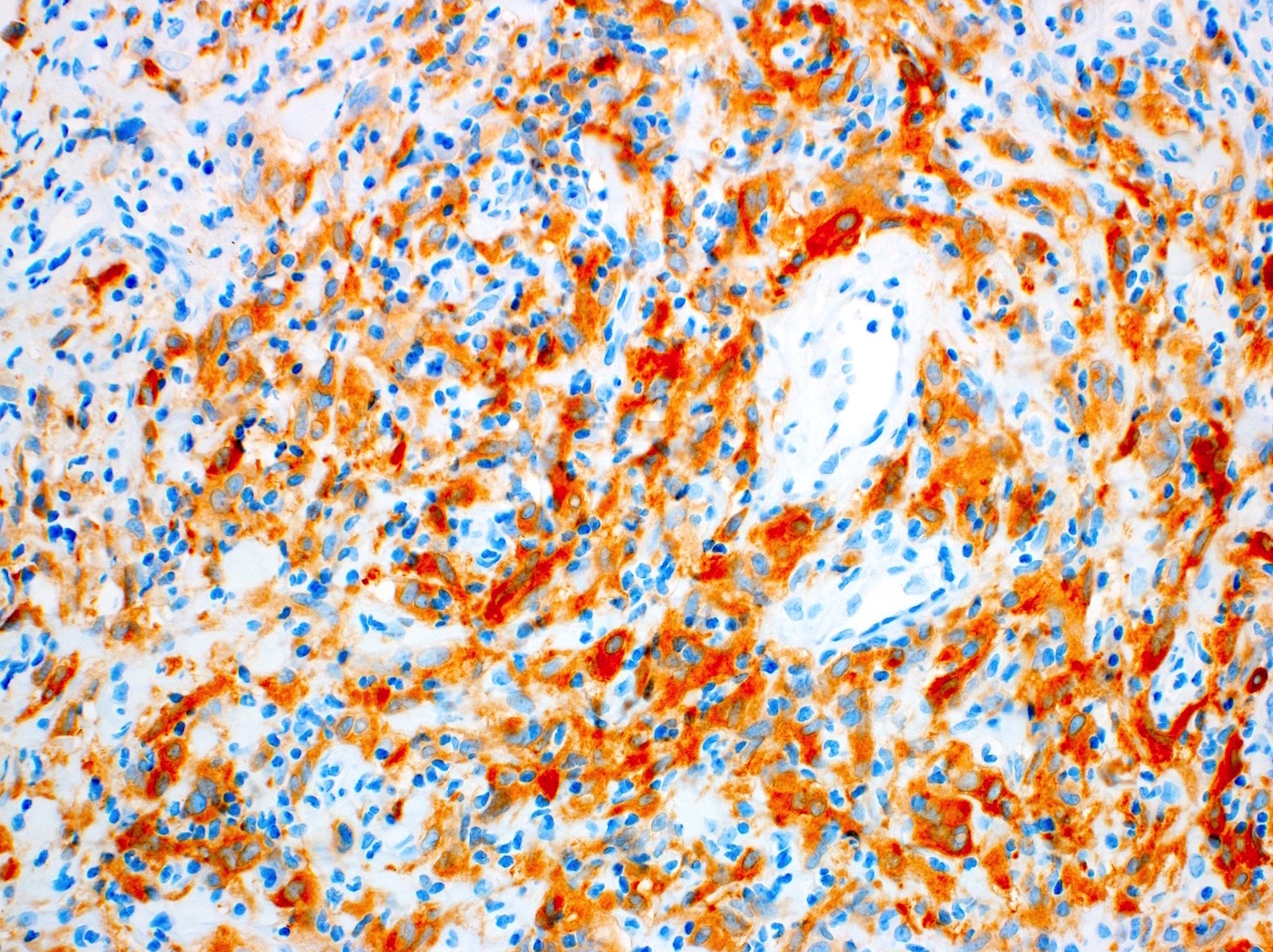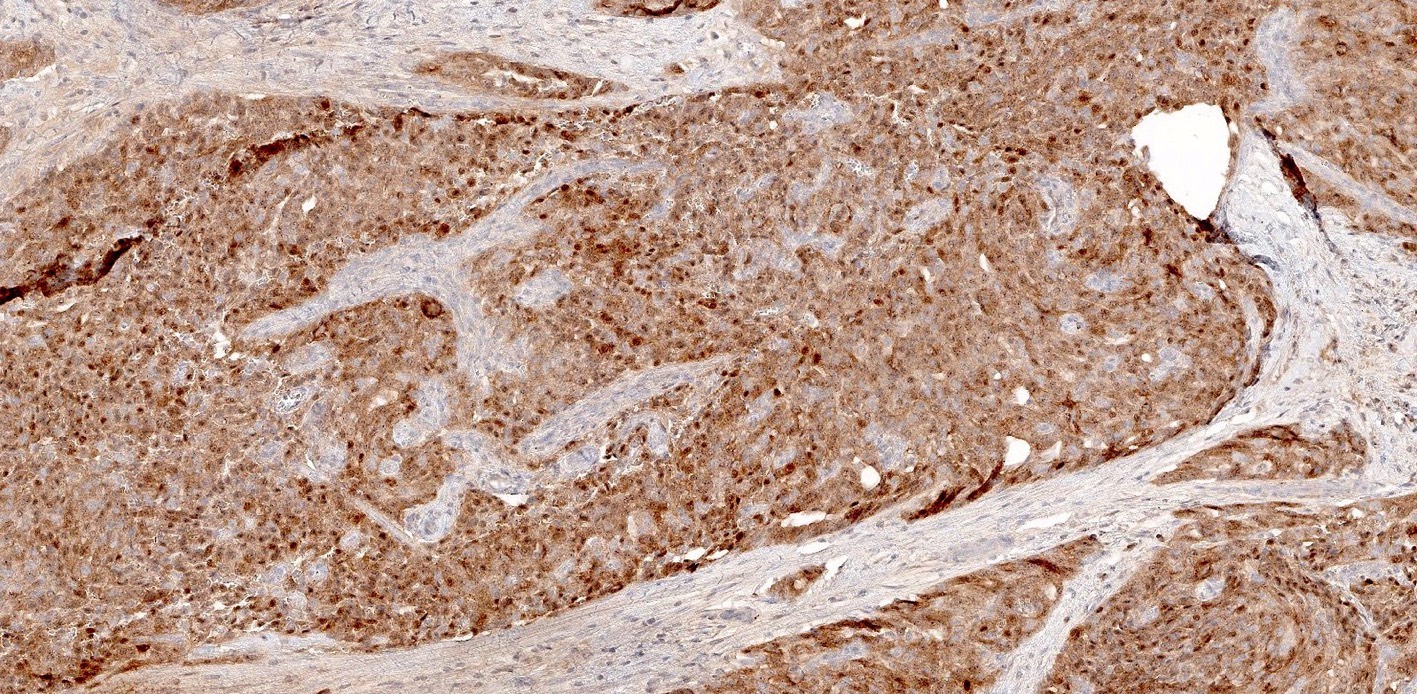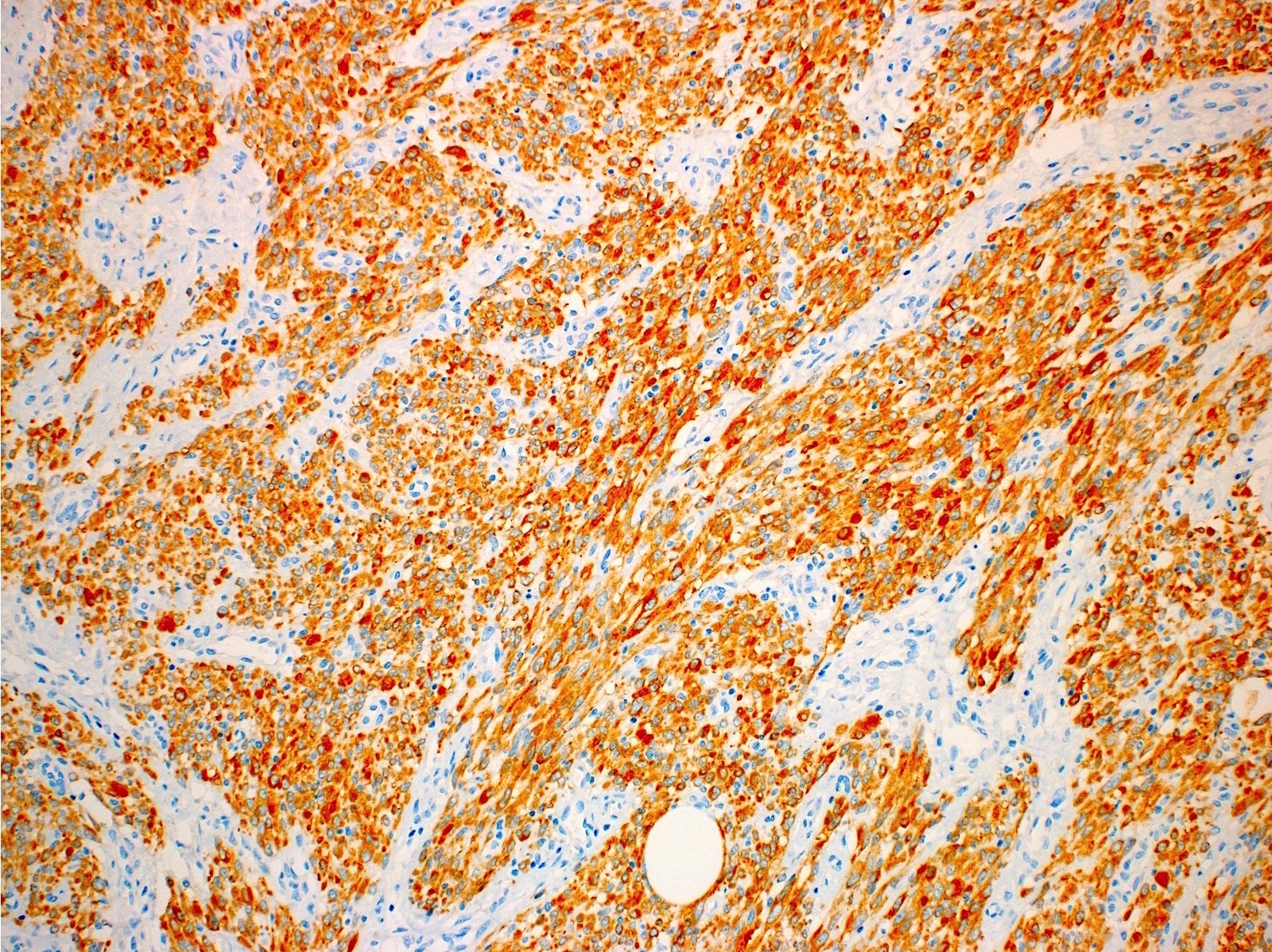Table of Contents
Definition / general | Essential features | Pathophysiology | Diagrams / tables | Clinical features | Interpretation | Uses by pathologists | Prognostic factors | Microscopic (histologic) images | Positive staining - normal | Positive staining - disease | Negative staining | Molecular / cytogenetics description | Molecular / cytogenetics images | Board review style question #1 | Board review style answer #1 | Board review style question #2 | Board review style answer #2Cite this page: Smith B, Davis JL. Pan-TRK (EPR17341) [NTRK]. PathologyOutlines.com website. https://www.pathologyoutlines.com/topic/stainsntrk.html. Accessed May 2nd, 2024.
Definition / general
- Family of receptor tyrosine kinases (NTRK1/2/3 genes with encode Trk-A, Trk-B, Trk-C protein kinases)
- Pan-TRK antibody recognizes C terminal domain of Trk-A, Trk-B and Trk-C (also available are Trk-A and Trk-C antibodies)
- 2 clones, EPR17341 and A7H6R, with concordance in NTRK rearranged tumors
- Neurotrophin signaling through these receptor kinases activate cellular pathways involved in cellular proliferation and survival, particularly within the embryonic nervous system (Annu Rev Biochem 2003;72:609, Annu Rev Neurosci 2001;24:677)
- Within embryonal development, regulate neuronal differentiation, axonal growth, dendritic growth and pruning and membrane trafficking, among other functions (Annu Rev Biochem 2003;72:609, Annu Rev Neurosci 2001;24:677)
- In adults, involved in synaptic strength and plasticity (Annu Rev Biochem 2003;72:609, Annu Rev Neurosci 2001;24:677)
Essential features
- Pan-TRK antibody recognizing C terminal domain of the Trk-A, Trk-B and Trk-C proteins encoded by the NTRK1/2/3 genes
- Can help identify tumors harboring NTRK1/2/3 fusions
- Variable expression pattern, depending on which NTRK gene is involved
- Variable sensitivity, depending on which NTRK gene is involved with lower sensitivity in NTRK3 gene fusions
Pathophysiology
- NTRK gene fusions (NTRK1/2/3) to a variety of gene partners are oncogenic drivers in several tumor types
- Recognition of NTRK fusion tumors is important with the advent of targeted Trk inhibitors
Clinical features
- Tumors with NTRK fusions are eligible for the FDA approved targeted TRK inhibitors larotrectinib and entrectinib
Interpretation
- Tumors harboring NTRK1/2 fusions demonstrate cytoplasmic expression; rare perinuclear and nuclear membrane staining has been reported
- Tumors harboring NTRK3 fusions demonstrate cytoplasmic or nuclear expression
- Some authors consider positive staining to be if ≥ 1% of tumor cells show expression, particularly for nuclear expression in NTRK3 fusions which may show only sparse staining (Mod Pathol 2020;33:38)
- Interpretation is best made in the context of morphology; false positive staining has rarely been reported in tumors in the absence of NTRK fusions, including BCOR rearranged sarcomas / primitive myxoid mesenchymal tumors of infancy (PMMTI), fibrous hamartoma of infancy (primitive mesenchymal component), neuroblastoma, oligodendroglioma, carcinomas with neuroendocrine differentiation, invasive ductal carcinoma of the breast and adenoid cystic carcinoma, among others; some of these tumors harbor structural rearrangements or amplifications in NTRK1-3 without gene fusions (Histopathology 2018;73:634, Mod Pathol 2020;33:38)
Uses by pathologists
- Aid in identification / diagnosis of NTRK fusion tumors (Am J Surg Pathol 2017;41:1547, Am J Surg Pathol 2018;42:927, Am J Surg Pathol 2018;42:791, Histopathology 2018;73:634)
- Screening tool or surrogate for molecular testing to confirm NTRK fusions (Am J Surg Pathol 2017;41:1547, Am J Surg Pathol 2018;42:927, Appl Immunohistochem Mol Morphol 2017;25:513)
- Sensitivity and specificity are generally high, with some exceptions depending on which gene is involved (i.e., lower sensitivity for NTRK3 fusions) and tumor type (see Mod Pathol 2020;33:38 for tumor specific sensitivity and specificity) (Am J Surg Pathol 2017;41:1547, Am J Surg Pathol 2018;42:927, Histopathology 2018;73:634, Mod Pathol 2019;32:147)
Prognostic factors
- Minimal prognostic information available; however, pan-Trk immunohistochemistry can be used as a screening tool and potential predictive marker
Microscopic (histologic) images
Positive staining - normal
- Testes (Am J Surg Pathol 2017;41:1547)
- Neural tissue (Mod Pathol 2020;33:38)
- Muscle tissue (Mod Pathol 2020;33:38)
Positive staining - disease
- Infantile fibrosarcoma (Am J Surg Pathol 2018;42:927, Pediatr Dev Pathol 2018;21:68, Histopathology 2018;73:634)
- Other pediatric and adult NTRK rearranged mesenchymal tumors (Am J Surg Pathol 2018;42:927, Pediatr Dev Pathol 2018;21:68, Histopathology 2018;73:634)
- Cellular (and some mixed) congenital mesoblastic nephroma (harboring NTRK gene rearrangements) (Am J Surg Pathol 2018;42:927)
- Uterine sarcoma with features of fibrosarcoma harboring NTRK fusions (Am J Surg Pathol 2018;42:791)
- Secretory carcinomas of breast and salivary gland (mammary analog secretory carcinoma) (most commonly contain ETV6::NTRK3 fusions) (Am J Surg Pathol 2017;41:1547)
- Other tumors harboring NTRK fusions: colorectal carcinoma (0.16 - 0.3%), glioblastomas, lung adenocarcinoma, melanoma (Am J Surg Pathol 2017;41:1547, Mod Pathol 2020;33:924)
- Inflammatory myofibroblastic tumor (IMT) (rare IMT may harbor NTRK fusion) (Histopathology 2020;76:774)
- In some tumor morphologies, NTRK fusions occur at a high frequency:
- Infantile fibrosarcoma (Am J Clin Pathol 2001;115:348)
- Other pediatric and adult NTRK rearranged mesenchymal tumors (Pediatr Dev Pathol 2018;21:68)
- Cellular (and some mixed) congenital mesoblastic nephroma (Mod Pathol 2000;13:29)
- Secretory carcinomas (breast, salivary gland mammary analog secretory carcinoma and skin) (Am J Surg Pathol 2019;43:1693, Am J Surg Pathol 2010;34:599, Am J Surg Pathol 2019;43:1092)
- Lipofibromatosis-like neural tumor (Am J Surg Pathol 2016;40:1407)
- Uterine sarcomas with NTRK fusions resembling fibromatosis (Am J Surg Pathol 2018;42:791)
- In some pediatric tumors, NTRK fusions occur with intermediate frequency:
- Pediatric gliomas, pediatric papillary thyroid carcinoma, Spitz nevi (JCO Precis Oncol 2018;2018:PO.18.00183, Cancer 2016;122:1097)
- In other tumors, NTRK fusions occur very infrequently (Mod Pathol 2020;33:38):
- Adult gliomas, adult papillary thyroid carcinoma, colorectal carcinoma, lung adenocarcinoma, melanoma, leukemia, and less commonly, others
Negative staining
- Dermatofibrosarcoma protuberans (DFSP) (Am J Surg Pathol 2018;42:927)
- Lipofibromatosis (Am J Surg Pathol 2018;42:927, Histopathology 2018;73:634)
- Myofibroma(tosis) (Am J Surg Pathol 2018;42:927, Histopathology 2018;73:634)
- Cellular myofibroma (Am J Surg Pathol 2018;42:927)
- Desmoid type fibromatosis (Am J Surg Pathol 2018;42:927, Histopathology 2018;73:634)
- Malignant peripheral nerve sheath tumor (MPNST) (Am J Surg Pathol 2018;42:927, Histopathology 2018;73:634)
- Spindle cell rhabdomyosarcoma (Am J Surg Pathol 2018;42:927, Histopathology 2018;73:634)
- Nodular fasciitis (Am J Surg Pathol 2018;42:927, Histopathology 2018;73:634)
- Schwannoma (Am J Surg Pathol 2018;42:927)
- Neurofibroma (Am J Surg Pathol 2018;42:927)
- Uterine leiomyosarcoma (Am J Surg Pathol 2017;41:1547)
- Classic mesoblastic nephroma, metanephric stromal tumor, clear cell sarcoma of kidney (Am J Surg Pathol 2018;42:927)
- Fibrous hamartoma of infancy (variable) (no staining: Am J Surg Pathol 2018;42:927, rare staining: Histopathology 2018;73:634)
- Synovial sarcoma (variable) (no staining: Am J Surg Pathol 2018;42:927, Am J Surg Pathol 2017;41:1547, rare staining: Histopathology 2018;73:634)
- BCOR sarcomas / primitive myxoid mesenchymal tumor of infancy (PMMTI) (variable) (Histopathology 2018;73:634)
Molecular / cytogenetics description
- Fluorescence in situ hybridization (FISH) probes for NTRK genes (or ETV6 which frequently is the fusion partner to NTRK3) are commercially available
- Some NGS assays (DNA or RNA) can detect / confirm NTRK fusions
Board review style question #1
A 2 month old boy presents with a large intramuscular thigh mass with encasement of the femoral neurovascular bundle. Biopsy shows a spindle cell neoplasm with infiltrative borders into skeletal muscle and subcutaneous adipose tissue. By immunohistochemistry, the tumor shows patchy expression of SMA, rare CD34 and diffuse expression of pan-TRK. What is the most likely diagnosis?
- Cellular congenital mesoblastic nephroma
- Infantile fibrosarcoma
- Lipofibromatosis
- Myofibroma
Board review style answer #1
B. Infantile fibrosarcoma. Infantile fibrosarcoma is the most common soft tissue sarcoma of infancy. The morphology can be variable but typically presents with primitive to spindle cells in a myxoid to collagenized stroma; the diagnosis can be confirmed with pan-TRK antibody staining. Tumors harbor an ETV6::NTRK3 fusion in ~70% of cases; however, recently other variant NTRK fusions have been described (Pediatr Dev Pathol 2018;21:68, Mod Pathol 2018;31:463).
Comment Here
Reference: Pan-TRK (EPR17341) [NTRK]
Comment Here
Reference: Pan-TRK (EPR17341) [NTRK]
Board review style question #2
- A 20 year old woman presents with a breast mass and a needle core biopsy is performed demonstrating morphology suggestive of secretory carcinoma. Which stain combination would be most consistent with secretory breast carcinoma?
- Pan-TRK+, S100+, MUC4+, ER-, GATA3+
- Pan-TRK+, S100-, MUC4+, ER+, GATA3+
- Pan-TRK-, S100-, MUC4+, ER+, GATA3+
- Pan-TRK+, S100+, MUC4+, ER+, GATA3+
Board review style answer #2
A. Pan-TRK+, S100+, MUC4+, ER-, GATA3+. Secretory carcinomas of the breast, salivary gland and skin are most commonly ETV6::NTRK3 driven tumors; rare ETV6 to other fusion partners have been described (Am J Surg Pathol 2015;39:602). Pan-TRK staining is seen, often with nuclear expression (NTRK3 fusion tumors). Breast secretory carcinomas also express S100, SOX10, MUC4 and GATA3 but are triple negative (ER / PR / HER2-).
Comment Here
Reference: Pan-TRK (EPR17341) [NTRK]
Comment Here
Reference: Pan-TRK (EPR17341) [NTRK]







